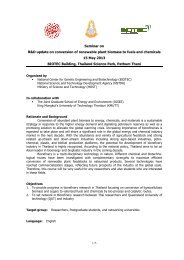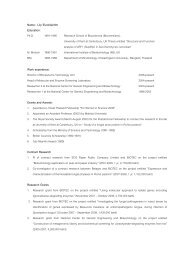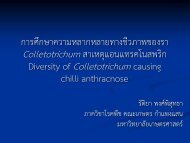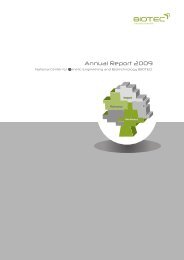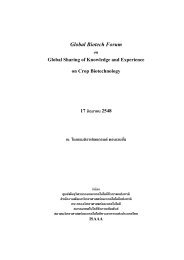The GMO experience in North and South America Greg Traxler
The GMO experience in North and South America Greg Traxler
The GMO experience in North and South America Greg Traxler
Create successful ePaper yourself
Turn your PDF publications into a flip-book with our unique Google optimized e-Paper software.
<strong>The</strong> <strong>GMO</strong> <strong>experience</strong> <strong>in</strong> <strong>North</strong> <strong>and</strong> <strong>South</strong> <strong>America</strong> 59Argent<strong>in</strong>a (Qaim <strong>and</strong> de Janvry, 2003) <strong>and</strong> Mexico (<strong>Traxler</strong> et al., 2003) suggest thatsmall farmers have had no more difficulty than larger farmers <strong>in</strong> adopt<strong>in</strong>g the newtechnologies.<strong>The</strong> environmental effects of transgenic crops have been strongly positive to date.In virtually all <strong>in</strong>stances <strong>in</strong>secticide use on Bt cotton is significantly lower than onconventional varieties <strong>and</strong> glyphosate has been substituted for more toxic <strong>and</strong> persistentherbicides <strong>in</strong> RR soybeans, canola, cotton <strong>and</strong> maize. Furthermore, an <strong>in</strong>crease <strong>in</strong> the useof reduced tillage has accompanied RR soybeans <strong>and</strong> cotton. Negative environmentalconsequences have not been documented <strong>in</strong> any sett<strong>in</strong>g where transgenic crops have beendeployed to date. Nonetheless, the long term environmental concerns deserve cont<strong>in</strong>uedmonitor<strong>in</strong>g because of the newness <strong>and</strong> the novel nature of genetic transformationtechnology. <strong>The</strong> ma<strong>in</strong> concerns voiced are whether <strong>in</strong>sect resistance to the Bt gene willdevelop, <strong>and</strong> whether gene flow to l<strong>and</strong>races <strong>and</strong> to related plant species will have anegative effect on biodiversity or to problems controll<strong>in</strong>g noxious weeds.<strong>The</strong> use of <strong>GMO</strong>s has delivered large benefits to many farmers <strong>in</strong> the NSam region,but one of the most strik<strong>in</strong>g aspects of the <strong>experience</strong> has been the concentration of<strong>GMO</strong> use to two traits <strong>and</strong> four major commercial crops <strong>in</strong> a few countries. Bt cotton <strong>and</strong>RR soybeans have been deployed to most of the ma<strong>in</strong> grow<strong>in</strong>g areas <strong>in</strong> Nsam. Bt maize<strong>and</strong> RR varieties of maize <strong>and</strong> cotton however have been limited to the USA, Canada <strong>and</strong>Argent<strong>in</strong>a. And no commercial <strong>GMO</strong> applications developed specifically to addressproblems of tropical agriculture here have yet appeared. <strong>The</strong> delivery of <strong>GMO</strong>shas also been concentrated <strong>in</strong> the h<strong>and</strong>s of a few providers. All <strong>GMO</strong>s have been basedon genetic events that are the property of mult<strong>in</strong>ational corporations. Many importantpolicy questions will have to be addressed over the com<strong>in</strong>g years if the benefits ofbiotechnology are to reach small farmers <strong>and</strong> growers of m<strong>in</strong>or crops (P<strong>in</strong>gali <strong>and</strong><strong>Traxler</strong>, 2002).At present all <strong>GMO</strong>s <strong>in</strong> use are the result of technology spillovers from theUS commercial seed market. With the exception of a few events <strong>in</strong> Ch<strong>in</strong>a, all <strong>GMO</strong>sgrown commercially anywhere <strong>in</strong> the world are derived from events developed forUS or Canadian markets. <strong>The</strong> private sector agricultural biotechnology <strong>in</strong>vestments of thepast 25 years were made with the one of these markets <strong>in</strong> m<strong>in</strong>d. 7 NSam conta<strong>in</strong>s five ofthe 14 largest seed markets (Table 7). <strong>The</strong> comb<strong>in</strong>ed seed market <strong>in</strong> these countries ismore than $9 billion. NSam countries have also been ahead of countries <strong>in</strong> other regionsto put biosafety committees <strong>in</strong> place. Four of the first five countries to approve events forcommercialisation are located <strong>in</strong> NSam (USA, Canada, Mexico <strong>and</strong> Argent<strong>in</strong>a), followedby Brazil <strong>in</strong> 1998. This reflects both the presence of public sector scientific capacityto perform the biosafety assessment, <strong>and</strong> a degree of political <strong>and</strong> social will<strong>in</strong>gness toaccept biotechnology – factors that many countries still struggle with. <strong>The</strong> many smallcountries of the hemisphere are severely disadvantaged with respect to their ability toattract <strong>in</strong>vestments <strong>in</strong> their seed markets, <strong>and</strong> with marshall<strong>in</strong>g the scientific talent neededto staff a national biosafety committee.<strong>The</strong> factors that have not been important are as <strong>in</strong>terest<strong>in</strong>g to consider as the factorsthat have been important. With the exception of canola <strong>in</strong> Canada, public sector scientificdiscoveries were not a part of the technology development phase of <strong>GMO</strong>s. Public sectorscientific contributions occurred far upstream, or were miss<strong>in</strong>g altogether. Paraguay is astrik<strong>in</strong>g example. In 2005 it had the sixth largest <strong>GMO</strong> area <strong>in</strong> the world, yet it has nobiotechnology research capacity. Secondly, <strong>GMO</strong> use <strong>in</strong> Brazil, Paraguay, <strong>and</strong> Argent<strong>in</strong>ahas occurred with limited or no ability to protect the <strong>in</strong>tellectual property of technology



